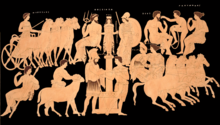俄诺玛俄斯
外观

俄诺玛俄斯(希腊语:Οινόμαος)是古希腊神话中的比萨王,[1]那伊阿得斯哈珀娜[2]或普勒阿得斯斯忒洛珀[3](有时也被认为是俄诺玛俄斯的配偶)[4]和战神阿瑞斯之子,希波达弥亚之父。除去斯忒洛珀的可能性之外,他的妻子也可能是阿尔戈斯的Evarete(阿克里西俄斯和欧律狄刻之女)。另外达那俄斯之女Eurythoe也被认为是他的母亲[5]或配偶。[6]除去希波达弥亚,他的孩子还有留基伯(因爱恋达佛涅而死)和阿尔卡珀。鲍桑尼亚认为俄诺玛俄斯的父亲不可能是神而是人类。[7]欧里庇得斯著作《在陶里斯的伊菲革涅亚》中的谱系证据显示,俄诺玛俄斯是特洛伊战争的前二代之人,是亚崔迪、阿伽门农和墨涅拉俄斯的祖父。
珀罗普斯与俄诺玛俄斯之死
[编辑]珀罗普斯想要娶俄诺玛俄斯之女希波达弥亚为妻,但是俄诺玛俄斯曾经得到一个预言:他将会被自己的女婿杀死,为了阻止这一事情发生,他通过战车赛杀死了13个来向希波达弥亚求婚的人,并将他们的头颅钉在宫殿的木柱上。[8]为了娶到希波达弥亚,珀罗普斯决定与俄诺玛俄斯比赛。为了保证不失败,珀罗普斯向波塞冬求助,后者交给他一辆飞马拉的战车。[9]珀罗普斯和希波达弥亚换掉了俄诺玛俄斯车轮上的车轴,因此俄诺玛俄斯因翻车被缰绳缠住,而被马拖死了。俄诺玛俄斯的车夫弥尔提洛斯幸存,但最终为珀罗普斯所杀。
弥尔提洛斯死前对珀罗普斯下了诅咒,导致后者的许多后代如阿特柔斯、梯厄斯忒斯、阿伽门农、墨涅拉俄斯和俄瑞斯忒斯都不得善终。同时弥尔提洛斯位于奥林匹亚的墓地也被认为是一个不祥之处。俄诺玛俄斯的战车赛被认为是古代奥林匹克运动会的起源之一,并产生了一些厄利斯传说。[10]
参考资料
[编辑]- ^ In the ancient territory of Pisa lay Olympia.
- ^ Theoi Project: Harpina (页面存档备份,存于互联网档案馆).
- ^ Hyginus, Fabula 84 ("Oenomaus, son of Mars and Asterope, daughter of Atlas"), Fabula 250 ("Oenomaus, son of Mars by Asterie, daughter of Atlas").
- ^ Pseudo-Apollodorus, Bibliotheke 3. 110 - 111; Pseudo-Hyginus, Astronomica 2. 21; he was depicted on the pediment of the Temple of Zeus at Olympia with Sterope, whom Pausanias also took for his wife: "On the right of Zeus Oinomaos with a helmet on his head, and by him Sterope his wife, who was one of the daughters of Atlas."
- ^ Scholia on Apollonius Rhodius, Argonautica, 1. 752
- ^ Tzetzes on Lycophron, 157
- ^ Pausanias, Description of Greece, 5. 1. 6
- ^ The story of Pelops' chariot race is told by Nestor to Menelaus, in Quintus Smyrnaeus's continuation of the Iliad (IV.527-34).
- ^ Cicero, Tusculanae Disputationes 2.27.67 (noted in Karl Kerenyi, The Heroes of the Greeks, 1959:64).
- ^ Eric L. Brulotte, "The "Pillar of Oinomaos" and the Location of Stadium I at Olympia", American Journal of Archaeology 98.1 (January 1994), pp. 53-64,
参考书目
[编辑]- Pindar, Olympian Ode, I (476 BCE)
- Sophocles, (1) Electra, 504 (430 - 415 BCE) & (2) Oenomaus, Fr. 433 (408 BCE)
- Euripides, Orestes, 1024-1062 (408 BCE)
- Bibliotheca, Epitome 2, 1-9 (140 BCE)
- Diodorus Siculus, Histories, 4.73 (1st c. BCE)
- Hyginus, Fables, 84: Oinomaus; Poetic Astronomy, ii (1st c. CE)
- Pausanias, Description of Greece, 5.1.3 - 7; 5.13.1; 6.21.9; 8.14.10 - 11 (ca. 160 - 176 CE)
- Philostratus the Elder Imagines, I.30: Pelops (170 - 245 CE)
- Philostratus the Younger, Imagines, 9: Pelops (ca. 200 - 245 CE)
- First Vatican Mythographer, 22: Myrtilus; Atreus et Thyestes
- Second Vatican Mythographer, 146: Oenomaus
